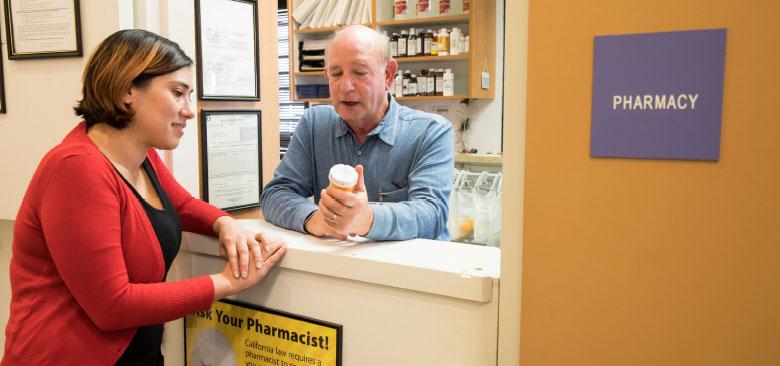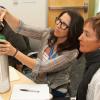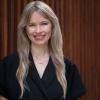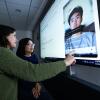
Psychiatric/mental health nurse practitioner Jamie Sanders consults with pharmacist Lester Bornheim at Marin Community Clinics (photo by Elisabeth Fall).
Novel IPE Partnership Aims to Expand Access to Mental Health Care
During a clinical rotation in the final year of her Psychiatric/Mental Health Nurse Practitioner (PMHNP) program at the UC San Francisco School of Nursing, Jamie Sanders saw a patient who was experiencing side effects from antipsychotic medication. Sanders was reducing the dose and considering introducing a relatively new medication that targets symptoms of tardive dyskinesia, one of the antipsychotic’s more debilitating residual effects.
“I had read the literature, but the clinical pharmacists I worked with had more in-depth knowledge,” says Sanders. “They gave me the answers I needed faster, and their answers were more salient, more specific, with suggestions about time frame [given the patient’s condition and other medications] and potential problems to monitor for. It was an instant response from someone I trusted.”
Sanders – who is now part of an interprofessional team at Marin Community Clinics – says there were also situations where clinical pharmacists wanted support for techniques that are integral parts of any NP’s tool set, such as motivational interviewing and physical assessment. She is particularly intrigued by the give-and-take between these two disciplines, because during her PMHNP training, she was part of an interprofessional pilot project, which its leaders at the UCSF schools of nursing and pharmacy believe is one of the first of its kind in the world.
Meeting a Need
 Chelsea Landolin and Patrick Finley The aptly named Dyad project – led by the School of Nursing’s Chelsea Landolin and the School of Pharmacy’s Patrick Finley – responds to two related needs. The first is a growing shortage of mental health providers in California. According to the Kaiser Family Foundation, a mental health provider shortage generally means having a population-to-provider ratio of more than 30,000 to 1. A study released in February 2018 by the Healthforce Center at UCSF projects that the state will have a “severe shortage of psychiatrists by 2028.”
Chelsea Landolin and Patrick Finley The aptly named Dyad project – led by the School of Nursing’s Chelsea Landolin and the School of Pharmacy’s Patrick Finley – responds to two related needs. The first is a growing shortage of mental health providers in California. According to the Kaiser Family Foundation, a mental health provider shortage generally means having a population-to-provider ratio of more than 30,000 to 1. A study released in February 2018 by the Healthforce Center at UCSF projects that the state will have a “severe shortage of psychiatrists by 2028.”
“In California, there are not enough mental health providers, and because they tend to be located in urban areas, people in rural areas are disproportionately impacted,” says Catherine Gilliss, dean of the School of Nursing. “Many people seeking mental health services are using medications to treat their illness, and medication support is also in short supply. [The Dyad] project adds capacity to the mental health team by creating provider partners who can safely meet the needs of more patients.”
The shortage of mental health professionals coincides with a growing need for clinicians who understand, deeply, how to work as part of a team. According to Barbara Brandt, director of the National Center for Interprofessional Practice and Education, “In the last seven to eight years, providers have dramatically increased their demands that schools prepare [trainees] to work in interprofessional environments.” The reasons include increased need for services due to the Affordable Care Act and Medicaid expansion, a move to value-based payments and coordinated care – and the shortage of physicians in underserved communities. Many have come to believe that other health care professionals, including NPs and clinical pharmacists – two professions that have demonstrated strong safety, cost-effectiveness and patient acceptability profiles – could help fill the gaps or better meet existing patient needs through a team-based approach.
 From left: Barbara Brandt, Catherine Gilliss, B. Joseph Guglielmo UCSF’s pilot aims to address both of these concerns in the hope that one plus one can equal three. “NPs and clinical psychiatric pharmacists have complementary skill sets – and our schools have the ability to more quickly and affordably fill the provider pipeline than medical schools and residency programs can produce psychiatrists,” says Landolin. UCSF’s PMHNP program alone graduates more than 30 freshly minted PMHNPs per year.
From left: Barbara Brandt, Catherine Gilliss, B. Joseph Guglielmo UCSF’s pilot aims to address both of these concerns in the hope that one plus one can equal three. “NPs and clinical psychiatric pharmacists have complementary skill sets – and our schools have the ability to more quickly and affordably fill the provider pipeline than medical schools and residency programs can produce psychiatrists,” says Landolin. UCSF’s PMHNP program alone graduates more than 30 freshly minted PMHNPs per year.
“NPs are experts in performing diagnostic evaluations and initiating treatment,” says Seth Gomez, a board-certified psychiatric pharmacist for Alameda County. “Pharmacists are medication experts, and those of us in psychiatric pharmacy work closely with clients to adjust their medications.” He says having the two professions work together has the potential to create effective management of larger patient panels than is currently possible in most settings.
“The underserved of the underserved medically ill are those with mental illness,” says B. Joseph Guglielmo, dean of the School of Pharmacy. “We are trying to create a model here that takes advantage of the strengths of our two schools and the uniqueness of this [health sciences] campus to address this underserved community.”
A Four-Part Program
 From left: Intern Rachel Kigano and Chelsea Landolin consult with a client at a Bonita House, Inc., clinic in Oakland, CA. (Photo by Elisabeth Fall.) The idea for the program emerged, in part, because Landolin periodically consults with Gomez in her clinical practice at Bonita House, Inc., a mental health agency in Oakland that treats adults with psychiatric disabilities and substance use disorders. Both Landolin and Gomez also precept students in their respective disciplines, and they would speak with each other periodically about ways to join forces. When Landolin joined the School of Nursing faculty in 2016, she and Gomez saw an opportunity to create a novel community-campus partnership for interprofessional education (IPE).
From left: Intern Rachel Kigano and Chelsea Landolin consult with a client at a Bonita House, Inc., clinic in Oakland, CA. (Photo by Elisabeth Fall.) The idea for the program emerged, in part, because Landolin periodically consults with Gomez in her clinical practice at Bonita House, Inc., a mental health agency in Oakland that treats adults with psychiatric disabilities and substance use disorders. Both Landolin and Gomez also precept students in their respective disciplines, and they would speak with each other periodically about ways to join forces. When Landolin joined the School of Nursing faculty in 2016, she and Gomez saw an opportunity to create a novel community-campus partnership for interprofessional education (IPE).
Landolin applied for a competitive grant offered by the National Center for Interprofessional Practice and Education in collaboration with the Robert Wood Johnson Foundation, The John A. Hartford Foundation, the Josiah Macy Jr. Foundation and the Gordon and Betty Moore Foundation – part of an effort to support recommendations in the Institute of Medicine’s 2010 Future of Nursing report. Landolin’s proposal was one of 16 chosen nationwide. In addition to a $50,000 grant, which the School of Nursing subsequently matched along with some additional support from the School of Pharmacy, the National Center provided tools, coaching and a site visit for development of this collaborative training model aimed at preparing students in both disciplines for back-and-forth consultation and co-management of mental health patients.
Specifically, preceptor dyads of practicing PMHNPs and clinical pharmacists support a group of trainee dyads of PMHNP master’s degree students and PharmD degree students through four types of experiences: a journal club, shared coursework and case discussions, clinical co-rotations and the use of a technology tool to foster greater collaboration.
“Some of the program is available to everyone in either school who wants to participate,” says Landolin. “Other pieces are limited to about 20 percent of each cohort.”
The journal club came first. In the 2016-2017 academic year, Gomez began guiding bimonthly discussions of a journal article that, in most cases, he would choose and distribute with a series of questions aimed at fostering critical thinking about how to analyze the literature and apply it in clinical practice. Gomez says that because each discipline brings its particular training to the discussions, the different perspectives make for some wonderfully full conversations. The club continues to this day, and the team is continually refining how it operates, with the ultimate vision of having a dyad of students choose the articles and present together.
Year one also saw the introduction of combined didactics. Finley teaches an elective course – an overview of mental health – at the School of Pharmacy, which he opened to students from the School of Nursing, either for enrollment or auditing. In 2017-2018, the Dyad team expanded the concept by having a PMHNP student and a psychiatric pharmacy resident prepare and collaboratively teach one of the sessions. In addition, Landolin invited pharmacy students to participate in a clinical assessment class she teaches. While she and Finley circulated, teams of PMHNP and pharmacy students assessed and developed a plan for a complex patient with both psychiatric and medical issues.
 Julie Nguyen and Seth Gomez Pharmacy student Julie Nguyen was one of the students. The leader of a local student chapter of a national organization for psychiatric and neurologic pharmacists, Nguyen says, “That day was really helpful to see how nursing students approach things differently from pharmacy. They were really knowledgeable, especially about how we should analyze a patient, and I would encourage more students to attend these types of interprofessional events.”
Julie Nguyen and Seth Gomez Pharmacy student Julie Nguyen was one of the students. The leader of a local student chapter of a national organization for psychiatric and neurologic pharmacists, Nguyen says, “That day was really helpful to see how nursing students approach things differently from pharmacy. They were really knowledgeable, especially about how we should analyze a patient, and I would encourage more students to attend these types of interprofessional events.”
“Many of the NP students are seasoned practitioners, and they gave our pharmacy students a much better appreciation for the psychosocial issues; it showed the students there is truly something to be gained from working alongside each other – it makes you a better practitioner,” says Finley, a board-certified psychiatric pharmacist who has had a practice in a depression clinic for 15 years. Both he and Gomez expressed a hope that the program could attract more pharmacy students to clinical psychiatric pharmacy.
While the financial support period is over now, after a site visit in the fall of 2018, the National Center is continuing its nonfinancial support to help implement the final two elements of the Dyad program. The team is currently lining up joint clinical rotations and working with the campus information technology (IT) services to facilitate experimentation with Health Insurance Portability and Accountability Act (HIPAA)-compliant texting. In both cases, the goal is to create lasting program elements that can foster ongoing collaboration.
Lessons Learned
Landolin says that as exciting and successful as the first two years have been, the team has also confronted many of the issues that seem to arise whenever the health professions try to implement IPE.
Most prominent are the logistical challenges. Identifying clinical rotations is an ongoing hurdle for individual schools; finding clinics that can simultaneously precept two separate disciplines complicates matters. Class schedules don’t always match up. Creating courses that address separate disciplines at different levels of training and experience is tricky.
In addition, at present, there are no proven models where PMHNPs and clinical psychiatric pharmacists actually co-manage patients – a challenge exacerbated by scope-of-practice limitations in California.
Brandt says most of these challenges and others arise in nearly every IPE effort, which at least partially explains why many health professions schools have fallen behind the demands of provider organizations and the communities they serve.
 Mary Dickow “We need to figure out how much has to change in order for IPE to become workable,” says Mary Dickow, statewide director of the California Action Coalition, who has served as an advisor on the Dyad project. “How can we create that good kind of tension between what students and practice sites need?”
Mary Dickow “We need to figure out how much has to change in order for IPE to become workable,” says Mary Dickow, statewide director of the California Action Coalition, who has served as an advisor on the Dyad project. “How can we create that good kind of tension between what students and practice sites need?”
Brandt may have one answer. She recently chaired a committee of national accreditation groups aimed at developing mandatory requirements for IPE. “We are very close to a consensus document, and this will send a message to the schools,” she says. “We all agree that one key piece is aligning much more tightly with community practice needs, so we encourage people to start at the end of the curriculum. We don’t just need IPE on day one, in the classroom, but we need it in the community.… There are barriers, but we will get over them.”
Both Gilliss and Guglielmo agree. “We will solve the barriers,” says Guglielmo. “The pilot…can guide us in breaking down the programmatic barriers. And we are especially enthusiastic about creating practice models that benefit each profession and, more importantly, benefit patients.”
“Once providers have the chance to actually work together, test each other’s knowledge and rely on one another, they truly understand the value of team practice,” says Gilliss.
Sanders notes that having those opportunities while in training is crucial, because learners may be more open to understanding the roles and knowledge base of their colleagues and how to do things as deceptively simple as framing questions or offering support.
“I’m not going to try to tell a primary care provider how to handle lifestyle concerns, but if they’re managing a [complex] patient on multiple medications – and want to try cognitive behavioral therapy to help a patient make better lifestyle choices, I might ask how I can support that process,” Sanders says. “Reading our colleagues and understanding how to navigate different roles without stepping on toes really benefits from practice.”
Solutions Emerging
The good news, say all participants, is that efforts like the Dyad project are emerging all over the country. Among the most promising:
- A school of nursing partnered with a local housing authority to build a primary care clinic, which has already treated nearly 800 patients, providing access to care that many did not have before. “The students in the clinic are learning team-based skills involving physicians, nurses, NPs, occupational and physical therapists,” says Brandt.
- A skilled nursing facility (SNF) developed a module that teaches teamwork for working with a geriatric population. While medical and nursing students rotated through the SNF, the project has been able to demonstrate reduced readmission rates and improved care coordination.
- And while it’s not part of the National Center’s cohort, Brandt also points to the long-standing UCSF program at the San Francisco VA Medical Center known as Patient Aligned Care Teams (PACT), which trains NPs and medical residents together to deliver primary care in teams.
Brandt says the National Center is gathering the emerging plans and tools to guide future efforts, and Dickow is among those excited by all the progress. “People need the nuts and bolts of how to do this – the basic skills and language for engaging stakeholders – because these types of partnerships make so much sense on so many levels,” she says.
But she also cautions that one of the most important lessons is an old one: “Building community partnerships and creating win-win situations takes an immense amount of work. People underestimate just how much. It’s not a one-time, annual event kind of thing; it’s an ongoing, two-way process of relationship building between schools and community partners.”
She adds that part of the effort must involve commitment from the top, which she says is readily apparent in the Dyad project, where both Dean Gilliss and Dean Guglielmo are visibly on board.
What’s Next for the Dyad?
Their commitment matters because the Dyad still has work to complete. In addition to implementing the clinical rotations and the technology project, the team is also planning a thorough evaluation of its work.
It will report on the number of students who participated and do periodic measures of their attitudes toward interdisciplinary practice, using a validated tool called the Assessment for Collaborative Environments (ACE-15). Patients treated by Dyad students will receive three different surveys: the Centers for Disease Control and Prevention’s Healthy Days Measures, a questionnaire on how well the team seemed to function and one about patient satisfaction.
 “It’s amazing what happens when you see the same content from different perspectives.” –Jamie Sanders (photo by Elisabeth Fall) “These will be small numbers, but hopefully we can identify some trends,” says Landolin. And regardless of what the evaluation shows, Landolin and Finley are planning to forge ahead. “We’ve already applied for [Gomez] to have an appointment at the School [of Nursing], so we can continue benefiting from his expertise, and we’ve arranged a meeting between the PMHNP specialty director and the person in charge of clinical placement on the pharmacy side to ease efforts to find clinical co-rotations.” The School of Pharmacy is also working to get Gomez an appointment there.
“It’s amazing what happens when you see the same content from different perspectives.” –Jamie Sanders (photo by Elisabeth Fall) “These will be small numbers, but hopefully we can identify some trends,” says Landolin. And regardless of what the evaluation shows, Landolin and Finley are planning to forge ahead. “We’ve already applied for [Gomez] to have an appointment at the School [of Nursing], so we can continue benefiting from his expertise, and we’ve arranged a meeting between the PMHNP specialty director and the person in charge of clinical placement on the pharmacy side to ease efforts to find clinical co-rotations.” The School of Pharmacy is also working to get Gomez an appointment there.
Sanders is among those enthusiastic about sustaining and growing this effort, because, she says, “It’s amazing what happens when you see the same content from different perspectives. You get a much more expansive and holistic understanding that leads to more innovative and creative solutions.”



